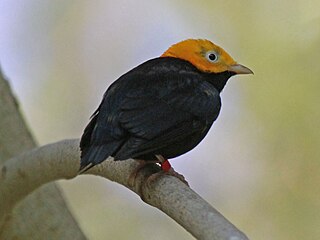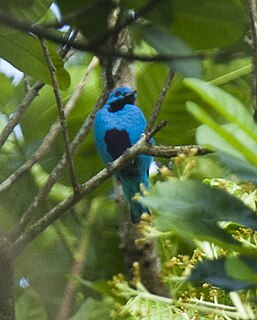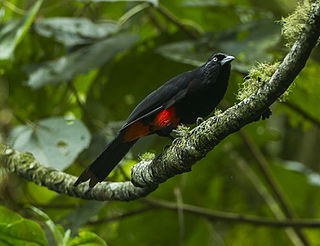
The crested oropendola, also known as the Suriname crested oropendola or the cornbird, is a New World tropical icterid bird. It is a resident breeder in lowland South America east of the Andes, from Panama and Colombia south to northern Argentina, as well as on Trinidad and Tobago. If the genus Gymnostinax for the Montezuma oropendola and its closest relatives were considered valid, this species would probably belong in that genus.

The golden-headed manakin is a small passerine bird which breeds in tropical Central and South America in both wet and dry forests, secondary growth and plantations. It is a small manakin, about 9.4 centimetres (3.7 in) long. Males are entirely black apart from a golden head, yellow bill, white and red thighs and pink legs. Females and juveniles are olive-green with pink legs. At breeding time, males are involved in a cooperative lekking behaviour during which they jump, slide and dart from perch to perch. This is a fairly common species with a wide range, and the International Union for Conservation of Nature has rated its conservation status as being of "least concern".

Oropendolas are a genus of passerine birds, Psarocolius, in the New World blackbird family Icteridae. They were formerly split among two or three different genera and are found in Central and South America.

The bronzed cowbird is a small icterid.

The spectacled owl is a large tropical owl native to the neotropics. It is a resident breeder in forests from southern Mexico and Trinidad, through Central America, south to southern Brazil, Paraguay and northwestern Argentina. There are six subspecies. One is occasionally treated as a separate species called the short-browed or brown spectacled owl but the consensus is that it is still merely a race until more detailed analysis can be done.

The chestnut-headed oropendola is a New World tropical icterid bird. The scientific name of the species commemorates Johann Georg Wagler, who established Psarocolius, the oropendola genus.

The Montezuma Oropendola is a New World tropical icterid bird. It is a resident breeder in the Caribbean coastal lowlands from southeastern Mexico to central Panama, but is absent from El Salvador and southern Guatemala. It also occurs on the Pacific slope of Nicaragua and Honduras and northwestern and southwestern Costa Rica. It is among the oropendola species sometimes separated in the genus Gymnostinops. The English and scientific names of this species commemorate the Aztec emperor Moctezuma II.

The scarlet-rumped cacique is a passerine bird species in the New World family Icteridae. It breeds from eastern Honduras to Panama and in the Pacific lowlands of South America from western Colombia south to Ecuador, and in the lower reaches of the northern Andes. There are several subspecies, some of which have been proposed for elevation to full species status.

The yellow-tailed oriole is a passerine bird in the New World family Icteridae. It breeds from southern Mexico to western Peru and northwestern Venezuela; in Peru it also lives in a river valley corridor.

The orange-collared manakin is a passerine bird in the manakin family. It is an endemic resident breeder in Costa Rica and western Panama, where it is found in forests, secondary growth and plantations. It is a small, plump bird about 10 centimetres (4 in) long. Males have a black crown, mid back, wings and tail and an olive-green rump. The rest of the head, neck, breast and upper back are orange, and the belly is yellow. Females are olive-green with yellow underparts and resemble female white-collared manakins. At breeding time, males are involved in lekking behaviour on the forest floor. This is a fairly common species with a somewhat restricted range, and the International Union for Conservation of Nature has rated its conservation status as being of "least concern".

The olive oropendola is the largest member of the icterid family and rivals the Amazonian umbrellabird as the largest passerine bird in South America. It is sometimes placed in the genus Gymnostinops instead of Psarocolius. As suggested by its name, it is found widely – but often in low densities – throughout humid lowland forests of the Amazon Basin, with the notable exception of most of the Guiana Shield. It is sometimes split into two species, the western olive oropendola and the eastern Pará oropendola, but the subspecies P. y. neivae is widely recognized as a hybrid swarm, and the vast majority of authorities consider them a single species.

The violet-bellied hummingbird is a species of hummingbird characterized by the male's shimmering violet belly.

The bare-shanked screech owl is a species of owl in the family Strigidae. It is a large owl that feeds at night in forests and lives in a family size group, even during breeding season. The owl's range is only in Costa Rica, Panama, and far northwestern Colombia. The owl preys on large insects, shrews, and small rodents.

The blue cotinga is a species of bird in the family Cotingidae. It is found in Colombia, north-west Ecuador, eastern and central Panama and western Venezuela in tropical moist lowland forests and heavily degraded former forest. In relation to range and population size this species is not considered to be vulnerable.

The red-bellied grackle is a species of bird in the family Icteridae. Its genus, Hypopyrrhus, is monotypic.

The tawny-breasted myiobius or tawny-breasted flycatcher is a species of passerine bird in the family Tityridae. It is found in Bolivia, Colombia, Ecuador, Panama, Peru, and Venezuela. Its natural habitat is subtropical or tropical moist montane forests.

The dusky-green oropendola is a species of bird in the family Icteridae. It is found on the eastern slope of the Andes in Bolivia and Peru. Its natural habitats are subtropical or tropical moist montane forests and heavily degraded former forest.

The Baudó oropendola is a species of bird in the family Icteridae. It is endemic to Colombia. Its natural habitat is subtropical or tropical moist lowland forests, which are threatened by destruction. As it is only known from a small number of locations, its conservation status has been assessed as "endangered" by the IUCN.

The green oropendola is a species of bird in the family Icteridae. It is found in wooded habitats in the Amazon basin and Guianas of South America, and is generally common. Uniquely among the oropendolas, the green oropendola has a pale bill with an orange tip. Male oropendola weigh around 400 grams, while females are in the 200 gram range. This is a common species and the International Union for Conservation of Nature has rated its status as being of "least concern".

The emerald tanager is a species of bird in the tanager family Thraupidae. It is found in Colombia, Costa Rica, Ecuador, and Panama. Described by the English ornithologists PL Sclater and Osbert Salvin in 1869, it is a medium-sized species that has a length of 10.6–13 cm (4.2–5.1 in) and a mass of 18–20.5 g (0.63–0.72 oz). It can be identified by its bright green plumage, with black streaking on the back and wings, and a black auricular patch and beak. It also has yellow on the crown and rump. The species shows slight sexual dimorphism, with the females being duller and having yellow-green in place of yellow on the head.






















